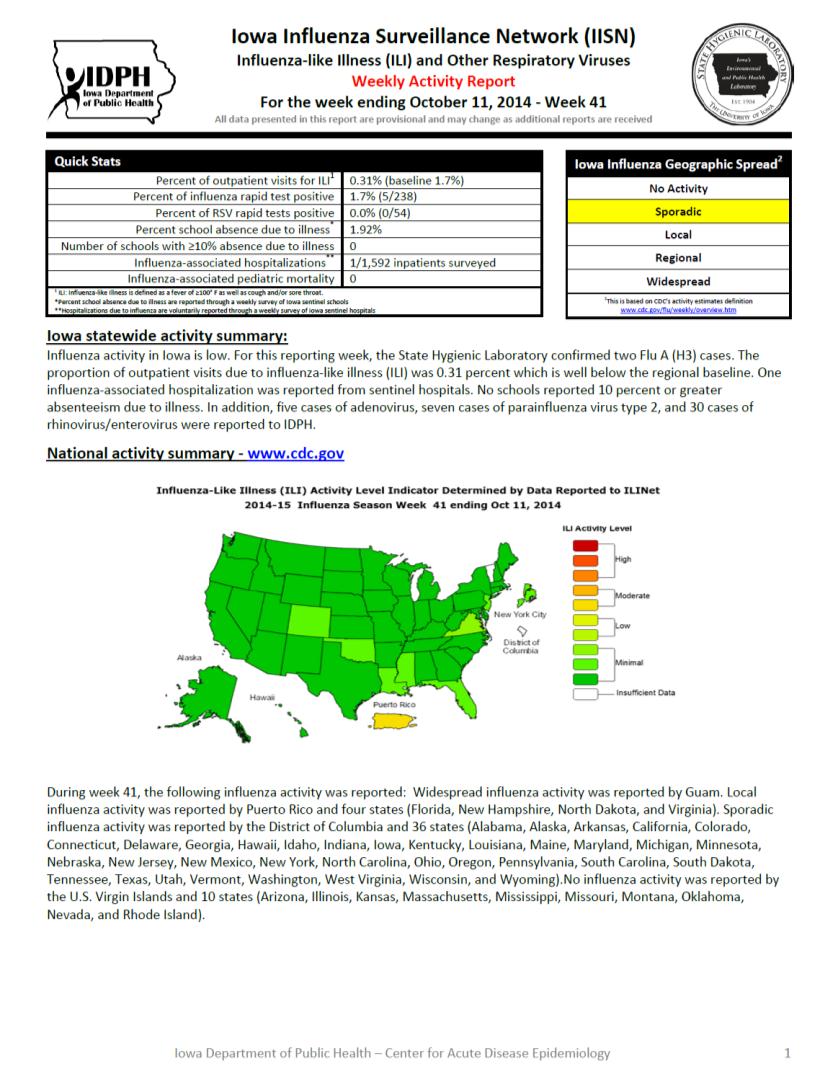Main title

Influenza Update for
Iowa Long-Term Care Facilities
Iowa Department of Public Health
Center for Acute Disease Epidemiology
Webinar Information
All participants will be muted during the presentation.
Questions can be submitted directly to the facilitator via the
question feature located on your control panel
All questions submitted will be answered at the end of the
This session will be recorded and made available for
reviewing When available, you will receive a follow-up-email on how
to access this recording
Discussion Points
Influenza Virus
Influenza Activity Nationally and in Iowa
Outbreak Management
Review of Antiviral Treatment and
Prophylaxis Recommendations
Presenters (In order of presentation)
Ann Garvey, DVM, MPH, MA, Deputy State Epidemiologist
Kemi Oni, MPH, Influenza Surveillance Coordinator, IDPH
Chris Galeazzi, MPH, Field Epidemiologist Unit Lead, IDPH
Patricia Quinlisk, MD, MPH, Medical Director, IDPH

Influenza Virus
Influenza Virus
Viral infection that mostly affects the respiratory system
— your nose, throat and lungs Symptoms include fever, cough, sore throat, runny or stuffy
nose, body aches, headache, chills and fatigue.
Some people may also have vomiting and diarrhea (they
will also have fever & respiratory symptoms) Outbreaks of diarrhea and vomiting alone are frequently
caused by Noroviruses (sometimes called Stomach flu)



Persons at Higher Risk for Severe Complications
Children <5 years
And people with medical
(especially <2 years)
conditions like:
Adults >65 years
Pregnant women
Neurological conditions
American Indians &
Chronic lung disease
Heart disease Blood disorders Endocrine disorders Kidney disorders Liver disorders Metabolic disorders Weakened immune system

Influenza in persons > 65 years
Greatest risk of serious complications 90% of influenza-related deaths 50% to 60% of influenza-related
hospitalizations

How Influenza Spreads
Droplets when people cough, sneeze, or talk
Droplets land in the mouths or noses of people who are
Also by touching surfaces with the virus on it and then
touching your own mouth, eyes, or nose
Usually spread from 1-day before symptoms start through 5-7days after becoming sick
Influenza Activity Update
National Estimates
Average of 300,000 Iowans get the flu every year
Flu and its complication of pneumonia cause an average
of 1,000 deaths yearly in Iowa
Peak Month of Flu Activity 1982-83 through 2013-14
Flu Activity Update - Iowa
Widespread Activity
All three strains of influenza circulating
Flu A(H3N2) – 92%
Flu A(H1N1)pdm09 – 1%
Flu B(both Yamagata and Victoria lineage) – 4%
Hospitalization rate increasing (especially > 65 yrs)
This graph was generated using
data collected from sentinel
Flu Activity Update - Nationally
46 states reporting widespread activity
Flu A(H3N2) viruses most common (>99% of all subtyped flu A
H3N2-predominiated seasons associated with more severe
illness and mortality, especially in children and older persons
Hospitalization rates in >65 increasing steeply
More than 2/3 of flu A(H3N2) viruses circulating are not well
matched to this years vaccine
LTC Outbreaks Reported to IDPH
IDPH continues to receive reports of influenza-related
outbreaks in long term care facilities
There have been 46 reported influenza outbreaks (since
October 1, 2014)
# of outbreaks
Region 1 (Central)
Region 2 (NE)
Region 3 (NW)
Region 4 (SW)
Region 5 (SE)
Region 6 (Eastern)

Weekly Influenza Report
Posted weekly at IDPH website
To learn more about our Influenza surveillance, please contact Kemi Oni, MPH 515-725-2136 [email protected]
Outbreak Management
Public Health defines an outbreak as…
One laboratory confirmed case of influenza
Another symptomatic patient
(within 72 hours)
Report to Public Health
Review national recommendations
Arranging specimen transportation
Provide additional consultation/support
Confirm the Cause of Illness
While Positive Rapid Test Results can help
guide outbreak decisions
Negative Rapid Test Results do not exclude
influenza as the cause of the outbreak (limited sensitivity)
Confirmatory testing at SHL is recommended
Implement Standard & Droplet Precautions
All residents with suspected or confirmed influenza
Standard Precautions
Gloves with hand contact with respiratory secretions or contaminated
Gown if soiling of clothes with respiratory secretions anticipated
Changing gloves and gowns after each encounter and performing hand
Droplet Precautions
In place for 7-days after onset or 24-hours after fever and
symptoms resolve- whichever is longer
Ill patients in private room, if possible
Wear facemask when enter room
CDC Antiviral Recommendations
All long-term care facility residents who have
confirmed or suspected influenza should receive antiviral treatment
Antiviral chemoprophylaxis is recommended for all
non-ill residents, regardless of whether they received influenza vaccination during the previous fall
Methods to Decrease Transmission
Restrict common activities
Limit large group activities Consider serving meals in rooms
Avoid new admissions
Or transfers to wards with symptomatic residents
Limit visitation
Exclude ill persons from visiting Post notices
Monitor personnel absenteeism due to respiratory illness
Exclude those with ILI for at least 24 hours after fever resolves
Restrict personnel movement from areas having illness to
those not affected by outbreak
Vaccination
Routinely (every year) influenza vaccination
should be provided to long term care residents and personnel
During outbreaks administer influenza vaccine
to unvaccinated residents and personnel
Daily Surveillance
Conduct daily active surveillance for respiratory
illness among ill residents, health care personnel and visitors to the facility
Until at least 1 week after the last confirmed
influenza case occurred
Antiviral Treatment and
Prophylaxis
Antiviral Agents for Influenza
Neuraminidase inhibitors (primary agents for A
and B influenza) Oseltamivir (Tamiflu®) Zanamivir (Relenza®)
Adamantanes (most A's resistant - not used)
Amantadines Rimantanes
Peramivir (Rapivab®)
IV administration only
General Treatment Efficacy of
Neuraminidase Inhibitors
Reduces uncomplicated illness by 1 day when given within 48
hours of onset of illness
In young children, reduced illness by 3.5 days if given within 24
hours of onset of illness
No or minimal effect in healthy people if started after 48 hours
after onset of illness
Secondary pneumonia decreased by 50% in adults with lab
confirmed flu if treated
Risk of death reduced after treatment Children studies showed variable but reduced secondary
infections after treatment, less asthma impact
CDC Antiviral Treatment Recommendations
All long-term care facility residents with
confirmed or suspected influenza should
receive antiviral treatment immediately
• Treatment should not wait for laboratory confirmation of
• Antiviral treatment works best when started within the
first 2 days of symptoms.
• However, these medications can still help when given after 48
hours to those that are very sick, such as those who are hospitalized, or those who have progressive illness.
Antiviral Treatment Dosage
Duration for antiviral treatment is 5 days
Zanamivir (Relenza – inhaled powder)
2 inhalations of 10 mg twice daily, dose varies by child's weight
Treatment – not approved in <7 years of age
Oseltamivir (Tamiflu – tablet)
Children (under 40 Kg) dose varies by weight
Adults (older children 40+ kg) 75 mg twice daily
CDC Antiviral Prophylaxis Recommendations
All eligible residents in the entire long-term care facility
(not just currently impacted wards) should receive antiviral chemoprophylaxis as soon as an influenza outbreak is determined Regardless of whether they received influenza vaccination Priority should be given to residents living in the same unit or
floor as an ill resident
However, since staff and residents may spread influenza to
residents on other units, floors, or buildings of the same facility, all non-ill residents are recommended to receive antiviral chemoprophylaxis to control influenza outbreaks
Antiviral Prophylaxis Dosage
Zanamivir (Relenza – inhaled powder)
2 inhalations (10 mg) once daily Not approved for children <5 years of age
Oseltamivir (Tamiflu – tablet)
Children one year and older (<40 kg) dose varies by weight Older children and adult (40+ kg) 75 mg once daily
CDC recommends antiviral chemoprophylaxis for a minimum
of 2 weeks, and continuing for at least 7 days after the last
known case was identified.
See Influenza Antiviral Drugs at
Antiviral Medications are Especially Important
this Season
H3N2-predominant flu seasons have been associated with
more hospitalizations and deaths in older people and young children in the past High hospitalization rates are being observed Hospitalization rates are especially high among people 65 years
2/3 of the H3N2 viruses that have been tested at CDC are
not well matched to this years vaccine, suggesting vaccine effectiveness may be reduced this season
Questions?
Source: http://www.iowahealthcare.org/UserDocs/Influenza_Update_for_LTC_012015.pdf
Clinical MCQs Assessment – Sample Questions The fol owing 20 clinical MCQs are representative of the style and format of MCQs that candidates wil receive as part of the AACP Stage 2 Clinical MCQ Assessment. The answers and explanatory notes are provided at the end of this document. SQ1. Which ONE of the following patients has the HIGHEST calculated creatinine clearance?
Scottish Intercollegiate Guidelines NetworkPart of NHS Quality Improvement Scotland Autism spectrum disordersBooklet for parents and carers We would like to thank all the young people who took part in the focus groups to provide us with their ideas and illustrations for this booklet. © Scottish Intercollegiate Guidelines Network ISBN 978 1 905813 27 8











